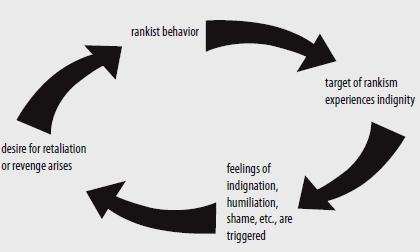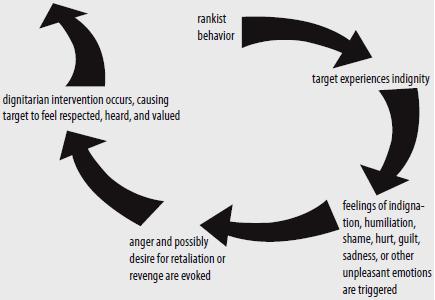chapter three
Naming the Solution
Let’s face it. Humans are predatory animals. Throughout history, the stronger or more powerful members of our species have preyed upon the weaker among us. Because this predatory—i.e., rankist—behavior has such deep historical roots, it can be hard to imagine a world that has rank without rankism. It can be hard to envision a world where rank holders use their rank to protect the dignity of all.
But we can begin to imagine such a world. In fact, moving beyond our predatory instincts may well be the only sane course of action if we want to have a chance at species survival. We live today in a world with massive societal challenges—poverty, famine, crime, disease, climate change, and war. We possess weaponry that cannot be reliably confined or controlled. As rankism begets further rankism, cycles of rankism escalate. If ever we are to free ourselves from retaliatory rankist behavior, we will need to disallow rankism, and instead create cultures of dignity.
It’s a daunting task, but not impossible. Time and again, humans have shown that we can choose a worthy goal and accomplish it. The end of apartheid in South Africa, segregation in America, and the tyrannies of communism in formerly Iron Curtain countries are the result of movements that began with a vision of dignity for all and accomplished significant dignitarian goals.
Moreover, humans have demonstrated that we have the capacity to interrupt the cycle of rankism [See Diagrams 1 and 2], by choosing to respond to indignity in a dignitarian way. An outstanding example is when Nelson Mandela came to power as president of South Africa after spending 27 years as a political prisoner. The new government he headed chose to pursue a path of peace and reconciliation, rather than revenge, for the brutalities committed under apartheid.
Dignity Works
Rank without rankism is a new social construct. It carries with it the understanding that rank in itself is not the problem; rankism is the problem. Rank can be used to protect human dignity, not debase it. Rank can be used to bring order, harmony, and efficiency to the accomplishment of worthy goals. Rank can be used to benefit others, not to serve our own egos or enrich ourselves at the expense of others. In fact, rank is often useful, even essential, to get things done. Rank can even be helpful for ending rankism. It is much easier, for example, to raise standards of behavior within an organization when a person of high rank helps establish and enforce practices that preserve dignity for all than when those of lower rank must risk being fired for trying to create such changes on their own.
Diagram 1: The Cycle of Rankism

The cycle of rankism begins with a rankist attitude or behavior. The target of the rankism experiences indignity, which typically triggers emotions such as humiliation, shame, guilt, sadness, or other unpleasant feelings. A desire for retaliation or revenge arises, which, unless interrupted, engenders rankist behavior, continuing the cycle of rankism begetting more rankism.
As we envision a world of rank without rankism, we lay the groundwork for a dignitarian world to become reality. And then a hidden truth reveals itself: dignity works. Dignity produces not only more effective and efficient operations, but also more contented, creative, and productive people. In the future, the world will be led by the societies, organizations, and individuals that value and ensure dignity for all.
Diagram 2: The Cycle of Rankism Interrupted
dignity behavior—the cycle is broken and more dignity-honoring behavior is likely, from both parties

When the cycle of rankism is interrupted by a dignitarian intervention—with someone pointing out the rankist offense in a way that protects the dignity of the perpetrator and/or acknowledgment of the offense by the perpetrator, followed by a behavior that honors the other’s dignity— the rankism cycle transforms and the potential for continued dignitarian behavior increases.
“For his book Good to Great, Jim Collins sifted through the 1,435 firms that have ever been in the Fortune 500. He found only 11 firms that demonstrated periods of exceptional performance. Notably, all 11 had CEOs who were…humble. ‘Humble’ is Collins’s word, and by it he means a CEO who would listen to anyone, anytime, who might have something to offer to the CEO’s quest for success. In other words, these CEOs eliminated every trace of rankism from their work lives—and they, and their companies, won big.”
—Robert Knisely in Washington Monthly (April 2003)
KEY POINTS
- It is possible to have rank without rankism.
- It is also possible to interrupt the cycle of rankism, in which rankism begets more rankism.
- Rank in itself is not the problem; rank can be useful, good, and necessary. Rankism—the abuse of rank—is the problem.
- When rank is used to protect the dignity of all, a culture of dignity is created.
- Dignitarian environments produce higher performing organizations than do environments with high levels of rankism.
